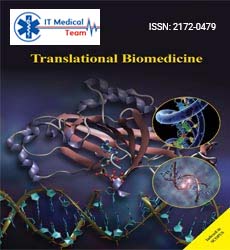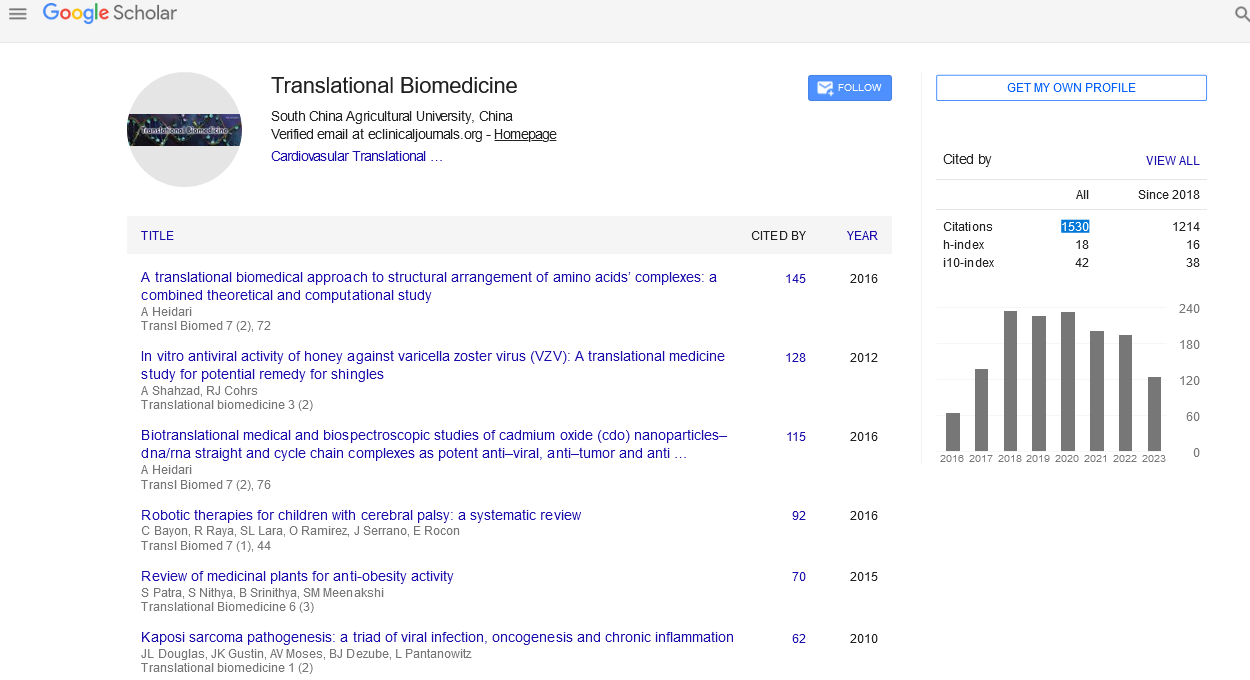Perspective - (2023) Volume 14, Issue 6
The intricate world of clinical hemorheology and microcirculation
Juan Enriquez*
Department of Hematology, Graves University, Salta, Argentina
*Correspondence:
Juan Enriquez, Department of Hematology, Graves University, Salta,
Argentina,
Email:
Received: 31-Oct-2023, Manuscript No. iptb-23-14235;
Editor assigned: 03-Nov-2023, Pre QC No. P-14235;
Reviewed: 17-Nov-2023, QC No. Q-14235;
Revised: 05-Dec-2023, Manuscript No. R-14235;
Published:
13-Dec-2023
Introduction
Hemorheology, the study of blood flow properties and
microcirculation, the network of tiny blood vessels, play
pivotal roles in our understanding of circulatory physiology
and its implications for various clinical conditions. This
article delves into the realm of clinical hemorheology and
microcirculation, exploring their significance, measurement
techniques and their impact on health and disease.
Description
Hemorheology
Hemorheology encompasses the study of blood's flow
properties and its interactions with the vascular system.
The physical characteristics of blood, such as viscosity,
deformability and shear stress, are critical in maintaining
proper circulation.
Blood viscosity: Blood viscosity refers to the thickness
or resistance to flow of blood. It is influenced by various
factors, including hematocrit (the proportion of red blood
cells in the blood), plasma viscosity and temperature. High
blood viscosity can lead to sluggish circulation, increasing
the risk of thrombosis and cardiovascular diseases.
Deformability of red blood cells: Red blood cells are highly
deformable, allowing them to squeeze through narrow
capillaries and transport oxygen efficiently. Abnormalities
in red blood cell deformability, such as in sickle cell disease
or thalassemia, can impair microcirculation and lead to
organ damage.
Shear stress: Shear stress is the force exerted by flowing
blood on the vessel walls. It is crucial for endothelial
function and vascular health. Abnormal shear stress
can lead to endothelial dysfunction, inflammation and
atherosclerosis.
Microcirculation: The capillary network
Microcirculation consists of the smallest blood vessels
in the body, including arterioles, venules and capillaries.
This network is responsible for delivering oxygen and
nutrients to tissues while removing waste products. The
microcirculation's integrity is vital for tissue perfusion and
overall health.
Capillary structure: Capillaries are the smallest and most numerous vessels in the microcirculation. Their structure
includes a single layer of endothelial cells, facilitating the
exchange of gases, nutrients and waste products between
the blood and tissues.
Nutrient exchange: Microcirculation is where oxygen
and nutrients are released from the bloodstream into the
surrounding tissues. Simultaneously, waste products, such
as carbon dioxide and metabolic byproducts, enter the
bloodstream for elimination. Any disruption in this process
can lead to tissue damage and dysfunction.
Clinical significance of hemorheology and
microcirculation
Understanding the intricacies of hemorheology and
microcirculation is of paramount importance in the clinical
setting. The interplay between these two factors affects
various aspects of health and disease.
Cardiovascular diseases: Hemorheological abnormalities,
such as increased blood viscosity and altered red blood
cell deformability, can contribute to the development of
cardiovascular diseases. Atherosclerosis, hypertension
and thrombosis are closely linked to impaired blood flow
properties.
Microvascular complications in diabetes: Diabetes is
associated with microvascular complications, including
diabetic retinopathy, neuropathy and nephropathy.
Impaired microcirculation in small blood vessels is a
hallmark of these conditions, leading to vision problems,
nerve damage and kidney dysfunction.
Inflammation and endothelial dysfunction: Chronic
inflammation and endothelial dysfunction are
interconnected with alterations in blood flow and
microcirculation. These factors play a significant role in the
development of diseases such as atherosclerosis, stroke and
sepsis.
Measurement techniques in hemorheology
and microcirculation
Accurate assessment of hemorheological and
microcirculatory parameters is crucial for understanding
their clinical implications. Various techniques are employed
to measure these factors.
Blood viscosity measurement: Blood viscosity is often
measured using a viscometer. This device determines the
resistance to flow by subjecting blood to a controlled
shear stress, with variations in shear rate allowing for the
calculation of viscosity.
Red blood cell deformability: Red blood cell deformability
can be assessed through ektacytometry, Laser-assisted
Optical Rotational Cell Analyzer (LORCA) and
microfluidic devices. These techniques measure the ability
of red blood cells to change shape when subjected to
mechanical stress.
Capillary density and blood flow: Microcirculatory parameters can be evaluated using various imaging
techniques, including video microscopy, laser doppler
flowmetry a nd s idestream d ark-field im aging. The se
methods provide insights into capillary density and blood
flow velocity.
Therapeutic implications
A comprehensive understanding of hemorheology and
microcirculation has significant therapeutic implications.
Management and treatment of various diseases can be
informed by targeting these aspects of circulatory
physiology.
Blood viscosity reduction: In patients with high blood
viscosity, interventions such as hydration and the use of
antiplatelet agents can help reduce blood viscosity and
lower the risk of thrombosis and cardiovascular events.
Microcirculation enhancement: Improving
microcirculation is a critical focus in the management of
diseases associated with impaired tissue perfusion.
Therapies may include medications that relax blood
vessels, enhance endothelial function or address
underlying conditions like diabetes.
Targeted therapies: Advancements in understanding the
interplay between hemorheology and microcirculation
have led to the development of targeted therapies for
conditions like sickle cell disease, which aim to improve
red blood cell deformability and overall circulation.
Future directions
The fields of hemorheology and microcirculation continue
to evolve, offering promise for further understanding and
clinical applications.
Personalized medicine: Advances in technology and our
ability to analyze blood flow properties at the individual
level may lead to personalized treatment plans for
cardiovascular and microvascular diseases.
Innovative diagnostic tools: Emerging diagnostic tools,
such as microfluidic devices and nanotechnology, hold the
potential to provide more precise measurements of
hemorheological and microcirculatory parameters.
Therapeutic discoveries: Ongoing research may reveal
novel therapeutic targets for conditions related to
hemorheological and microcirculatory abnormalities,
ultimately improving patient outcomes.
Conclusion
Hemorheology and microcirculation are integral
components of circulatory physiology with profound
implications for health and disease. Understanding the
physical properties of blood and the microvascular
network is essential for the prevention, diagnosis and
management of a wide range of clinical conditions. As
research in these fields advances, it holds the promise of
improved treatments and a deeper understanding of the
intricate mechanisms governing our circulatory system.





